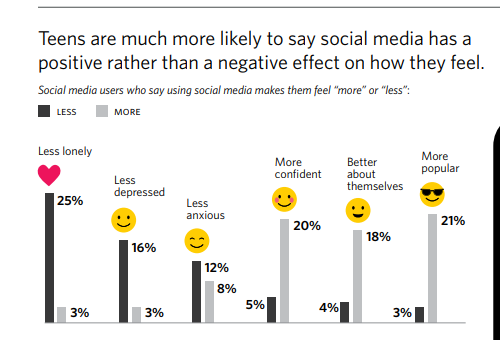Teens and Social Media Survey Says: It's Complicated
Common Sense Media finds that when it comes to social media and teens, there are no easy or definitive answers.
Common Sense Media (CSM), a nonprofit organization focused on kids and media and technology, released the results of its survey Social Media, Social Life. The report is based on the collected responses of 1,141 teens age 13 to 17. Following up on its 2012 survey of the same name, the organization found there is no way to easily classify the impact of social media and its use on teenagers in the United States. Parents and educators may want to declare Snapchat and Instagram all bad, but according to the young respondents, there is a lot of good to be gleaned from them, too.

All infographics credit: Common Sense Media, Social Media, Social Life
More teens say social media has a positive effect on how they feel about themselves—and they don’t report cyberbullying as a widespread problem. The large majority, 87 percent, of respondents said they had never been cyberbullied and less than 10 percent responded that they had been cyberbullied “many times” or “a few times.”
One of the key findings in the survey is that social media has a heightened role— both positive and negative—in the lives of more vulnerable teens.
The CSM survey included a social-emotional well-being (SEWB) scale based on concepts such as happiness, depression, loneliness, confidence, self-esteem, and parental relations. The 17 percent who scored in the low-SEWB group were the most impacted, suggesting that the child's personality—not the platform—is the more important factor when determining the influence of social media.
“What is most important to recognize from this survey is that their relationship with social media is not uniform or one dimensional,” the report said. “Social media is very important to them, helping many of them to feel less lonely, more confident, and more connected. But social media is also more likely to affect them negatively than it is for other teens—to make them feel left out, or worse about themselves.”


Other findings:
Social media use among teens has increased dramatically since 2012. The percentage of teens who use social media is about the same, but the frequency of use has changed. “The proportion of teens who use social media multiple times a day has doubled over the past six years. …In fact, 38 percent of teens today say they use social media multiple times an hour, including 16 percent who say they use it ‘almost constantly.’”
Teens’ preference for face-to-face communication with friends has declined substantially, and their perception of social media’s interference with personal interactions has increased. Only 32 percent say their favorite way to communicate with friends is in person (dropping from 49 percent in 2012) and teens are more likely to say they are distracted by social media when they are with other people (54 percent, up from 44).
There has been an uptick in teens’ exposure to racist, sexist, and homophobic content on social media . Nearly two-thirds (64 percent) said they “often” or “sometimes” come across racist, sexist, homophobic, or religious-based hate content in social media; one in five (21 percent) said they “often” do.
Social media is an important avenue of creative expression for many teens. More than a quarter of teens said social media is “extremely” or “very” important for expressing themselves creatively. THis was particularly true for the most vulnerable users.
Teens have a decidedly mixed record when it comes to self-regulating device use. Many young people do turn off, silence, or put away their phones when going to sleep, having meals with people, visiting family, or doing homework, but many do not. A significant number of teens, however, said they “hardly ever” or “never” silence or put away their devices when doing homework (37 percent), visiting family (34 percent), having meals with other people (31 percent), or going to sleep (26 percent).
RELATED
The job outlook in 2030: Librarians will be in demand
The job outlook in 2030: Librarians will be in demand
ALREADY A SUBSCRIBER? LOG IN
We are currently offering this content for free. Sign up now to activate your personal profile, where you can save articles for future viewing






Add Comment :-
Be the first reader to comment.
Comment Policy:
Comment should not be empty !!!